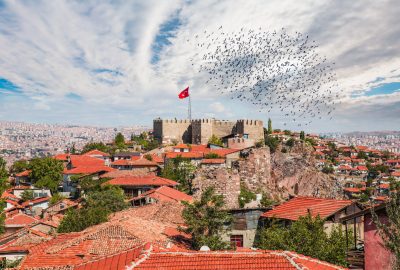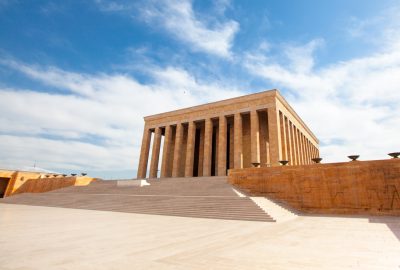Ankara became the capital of the Republic of Turkey in 1920. That is not that long ago in the grand scheme of things. But the city itself is much, much older. Remains of a settlement from the Bronze Age (2000 years BC) have been discovered. The official city named Ancyra was built around 1000 BC by Midas; the mythical king that turned everything into gold. Legends such as Alexander the Great, Roman Emperors and even Homer passed through that humble city. Ankara is one, huge archeological site and many relicts of Greek, Roman, Celtic, Byzantine and Ottoman architecture still remain undiscovered. You can walk around Roman Baths from the 2nd century, as if it was a park. You could probably sit down and pop a brew at the same spot that imperial generals chilled in a Jacuzzi. Ankara lacked that one thing that made Istanbul the capital for over 16 centuries: the localization.
So why did they make Ankara the capital? This nation didn’t have an easy past; there were empires, wars both won and lost and possibly a couple of bad political choices. Turkey found itself shrivelled to a fraction of its former power following the World War I. From this conundrum a real leader, a legend emerged: Mustafa Kemal Atatürk aimed to reclaim their homeland which resulted in the Turkish War of Independence, which formed Turkey as we know today. You can learn all about that war at the Independence War Museum, located near the Ulus Square. Atatürks Mausoleum Anıtkabir (which means literally memorial tomb in Turkish) is another must-see in the capital. Amazing how revered one person can be; this whole complex is nothing short of an Egyptian pyramid. All constructed for just one person and it’s not even ancient history since the guy was alive less than a hundred years ago. Why would they even move the capital from such an iconic site like Istanbul? Same reason why you don’t call your ex when sober, a fresh start, new beginning, leaving the past behind. They wanted Ankara to become the shining beacon, a place that would become a symbol of progress for the Turks.

Ankara Castle (Ankara Kalesi), also known as Ankara Citadel (Hisar), is situated on a hill top and offers great views over the entire city
Modern Turkey is fluid, unpredictable, some say that they’re a “nation of collective amnesia”, quick to forget political executions and oppression. The current rulers put their bets on centralized power, dogmas, nationalism and overall stupidity. They’re at a point that my European countries find themselves in. Eurosceptic populism is everywhere, people don’t trust outsiders and would rather sit in their own tents than be a part of something bigger. There are some who oppose that and they often end up missing. There are also some that approve of those politics. We’re all different, there are multidimensional people and there are the simple folks.
While Turkish politics are questionable, to say the least, the country is experiencing a tremendous economic growth and is transforming into something very unique and interesting. Ankara is an embodiment of this new direction that Turks are heading in. The capital is a city rich in history and a living testimony to Turkey’s financial and cultural growth. While not as monumental as Istanbul with its’ Ottoman palaces, it radiates its own, peculiar charm. Ankara is a city of students, education and vibrant nightlife. Streets are booming with restaurants, bars and café’s visited by an ever-increasing number of international youth that doesn’t seem to care about the current state of affairs or human rights. Local restaurants serve dishes that are not only a treat for the eye. The Turkish cuisine is one of the richest in the entire world.
Ankara is incomparable to Istanbul. It’s like comparing Milan to Rome. Both are the largest cities in a country but they’re completely different. One is rooted in the glorious past while the other is looking forward to the bright future. That said there’s still a lot to see, after all, there’s evidence of settlements in this area from 1200 BC, you can witness traces and relics of those times in the Museum of Anatolian Civilizations. This remarkable site houses artefacts from every single archeological site in Anatolia, statues, clay tablets, remains of primordial monkey-humans, all the good museum stuff that everyone loves so much. When Atatürk moved the capital, he wanted his people to be closer to nature and the animal kingdom, that’s why Ankara is so green, has so many parks and its zoo is populated with species from all over the world.

Anıtkabir (literally, "memorial tomb") erected for Mustafa Kemal Atatürk, founder of modern Turkey and first President of the Republic of Turkey, sits high above the city of Ankara
Nightlife in Ankara is a glorious mess, clearly inspired by Western Europe. Most bars are stylized after British pubs, such as the Newcastle Pub or the London Pub. Gardens and sidewalk cafés are crowded during the warmer months and that’s where the locals usually hang out. Ankara isn’t short on modern clubs, where world’s best DJs often perform. Turkey might have “borrowed” some ideas from the western cultures, but they’ve also contributed to the worldwide drinking culture with one of the most popular drunk-foods ever. Kebab, the iconic fast-food is miles above anything you’d get at your local kebab joint. Get ready for delicious meat roasted over open fire, fresh vegetables, marinades, spices, and sauces. It’s incomparable to the pre-made crap they’re feeding us poor, inebriated folks here in Europe.



No one commented yet. Be the first.